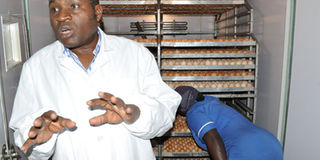Ochola hatched idea into multi-million chick business

Dr Okoth Ochola explains how the hatchery works while one of the workers arranges eggs. Below (R) Ochola picks out an egg. PHOTO by STEPHEN OTAGE
What you need to know:
Starting capital. He invested Shs1.5 million into the poultry project, starting with 300 birds that more than doubled to 700 three years later.
In 2000, after running a veterinary drug shop for some time, Dr Okoth Ochola realised none of his colleagues had ventured into the poultry sector.
Ochola and his wife Eve Ochola also felt income from the pharmacy was insufficient for them to make ends meet. They decided to inject the Shs1.5 million they had saved into a poultry project, buying 300 birds to start a backyard poultry farm.
In 2003, the poultry farm had more than doubled from 300 birds to almost 700 and it was generating more income of about Shs4 million compared to the pharmacy which encouraged them to double the effort and register a company in the name Asiima Agri-Consult Limited.
Today, the enterprise has evolved into a fully-fledged company operating in five districts of Uganda.
These include Amuru, where the company has 300 acres of land to plant maize and soya bean to feed the birds, Buikwe district where they have planted Eucalyptus and pine trees for future energy needs, Wakiso district where a hatchery and the brooders are located, Kampala district where the veterinary pharmacy is located and Mukono District where the company is opening a new venture in local chicken breeds.
The company boasts of seven departments which are located in each of the district and they feed into each other.
Process of production
When the birds lay eggs in Luweero, they are transferred to Kyaliwajjala in Wakiso District where they breed for three weeks.
The process involves receiving the fertilised eggs, fumigating them to disinfect them and transferring them to a cold room where temperatures are controlled using air conditioning at 19 degrees for one week.
After this, they are transferred to a setter room where they are sorted according to size, date, and breed of birds. Here, the eggs are kept in a setter room for 12 hours.
The eggs numbering 34,000 are rotated left and right after every one hour for proper development of the embryo. When the chicken embryo has developed, the next process is called candling.
This is where the fertilised eggs are separated from the unfertilised ones before they are rolled into the hatchery for 18 days.
After two days the chicks start popping out and they are packed in boxes where they are transferred in a holding room in order not to suffocate and to harden before they are dispatched to their shop for sale.
After the hardening, the chicks are sorted according to the quality of beak, feather, umbilical cord and they are sold according to classes. The first class is sold to the market. The other poor grades are given to commercial farmers for fattening and laying eggs. The hatchery has capacity to hatch 88,000 chicks.
Humble beginnings
Dr Ochola says since most of his fellow graduates were concentrating on dairy farming, he started importing poultry from Belgium, Kenya and South Africa in 2000, 2001 and 2002, respectively.
However, this excitement was almost short-lived because at the time, Sabena Airways used to import the birds but when they closed shop, they had most of their capital stuck with Sabena Airways since they could not fly the birds.
Luckily, they recovered it through friends abroad.
They learnt that importing chicks was not sustainable. That is when they started hatching them on a small scale while importing others until they reached the optimum level.
They used to hatch them from government hatcheries in Kigo, Kasangati and Entebbe until 2005 when they found it more efficient, cheaper and easier to hatch from here.
Challenges
High power bills which the company has to meet because they operate on power 24 hours, lack of qualified human resource, disease control, especially bio security and funding are some of the challenges that the company faces.
He explains that when they had just ventured into the business, no bank wanted to fund the venture because it was considered highly risky. With a human resource of 70 employees, the company last year registered a turnover of Shs4 billion.
Plans
He is planning to appraise all the departments to the level of attracting international funding as well as try and list on the stock exchange.
Tips
Start small and grow. “Ugandans should not despise humble beginnings because other opportunities will find them working,” Dr Ochola said.
Tapping into the regional market
Dr Ochola says indirectly, he is currently exporting to Kenya, Burundi and South Sudan.
Locally, he says during the market slump for chicks, sometimes he takes them to commercial farmers who slaughter them and return them to his farm as dressed chicken where buyers take between one and four tonnes.
Other farmers take the birds for fattening, while orders for eggs are coming from as far as Nimule, Malaba and Tororo.
He says for customers who purchase more than 2,000 layers, each bird costs Shs2,700. For those who purchase less than that, each goes for Shs2,600. Broilers cost Shs1,600 for bulk purchases while fewer orders cost Shs1,550 each.
Mission to popularise chicken eating
Dr Ochola and his wife want to educate people in their neighbourhood to get used to eating healthy chicken. They have started this by grilling chicken around Kyaliwajala trading centre. They also get orders to prepare grilled chicken for parties.
They also hope to train local farmers on how to hatch local chicken in order to improve their capacity.
Growing market
The demand for the birds was so high that people used to book the birds four to five months in advance.
When Dr Ochola started hatching in Uganda, they realised the need to integrate the vet drug shop with the hatchery to increase capacity.
Today, the farm boasts of 51,000 parent stock of birds and the company provides consultancy services to farmers.
Integrated farm
The company has its own food processing section which produces the feeds for the farm that needs 10 metric tonnes of food per day to run. They stock wheat bran, maize bran, cotton cake, soya cake and sunflower cake.
With two grinding mills which generate a tonne of food every 40 minutes, they are able to produce their own feeds because they just have to add micro-nutrients such as minerals, additives and salt.
Attracting foreign mergers
In 2008, a consultancy firm was looking for a firm to partner with Danish firms. When they advertised the bids, Asiima-Agri-Consultancy emerged the best. This enabled them to enter a business partnership when they signed a memorandum of understanding for a pilot phase of one year. Then, they signed another one of five years under which they were supposed to train both the workers and owners on how to operate machines, carry out environmental value addition to save energy on the farm using solar heaters, solar panels, fencing to control disease and the money injected would be refunded at a cost of between 50 per cent and 90 per cent.
A tray of eggs costs Shs7,500, commercial layers cost Shs8,000 and ordinary broilers cost Shs30,000 for the males while females cost Shs10,000 because they are smaller in size.
They got equipment in phases in 2005, 2007 and 2010 but got an in-put from Danida, which gave them two setters, two hatchers and they also outsourced equipment from India because of the technology which is easy to maintain rather than the costly and difficult to maintain ones from Europe.
The market
Whereas family planning advocates argue that Uganda’s high fertility rate is a problem, Dr Ochola says this is an opportunity because it means more mouths to feed and poultry is one business where it takes only six weeks to put food on the table because land is not increasing yet the population is rising.
He says even populated countries such as China and India are depending on poultry to feed the nation.
He encourages Ugandans to embrace poultry because compared to beef, which requires plenty of land, poultry can be done in the backyard.
His clientele ranges from small- scale farmers raring between 200 and 300 birds to medium-scale farmers handling between 500 birds and 1,000 birds and these are the majority compared to the large-scale farmers with between 8,000 to 10,000 birds.
The numbers
70
Number of people employed by Asiima Agri-Concern Limited.
Shs8,000
Average cost of a tray of eggs.
34,000
Number of eggs that can be hatched in a setter in a day.
88,000
Production capacity of the hatchery at a time depending on availability of eggs.




